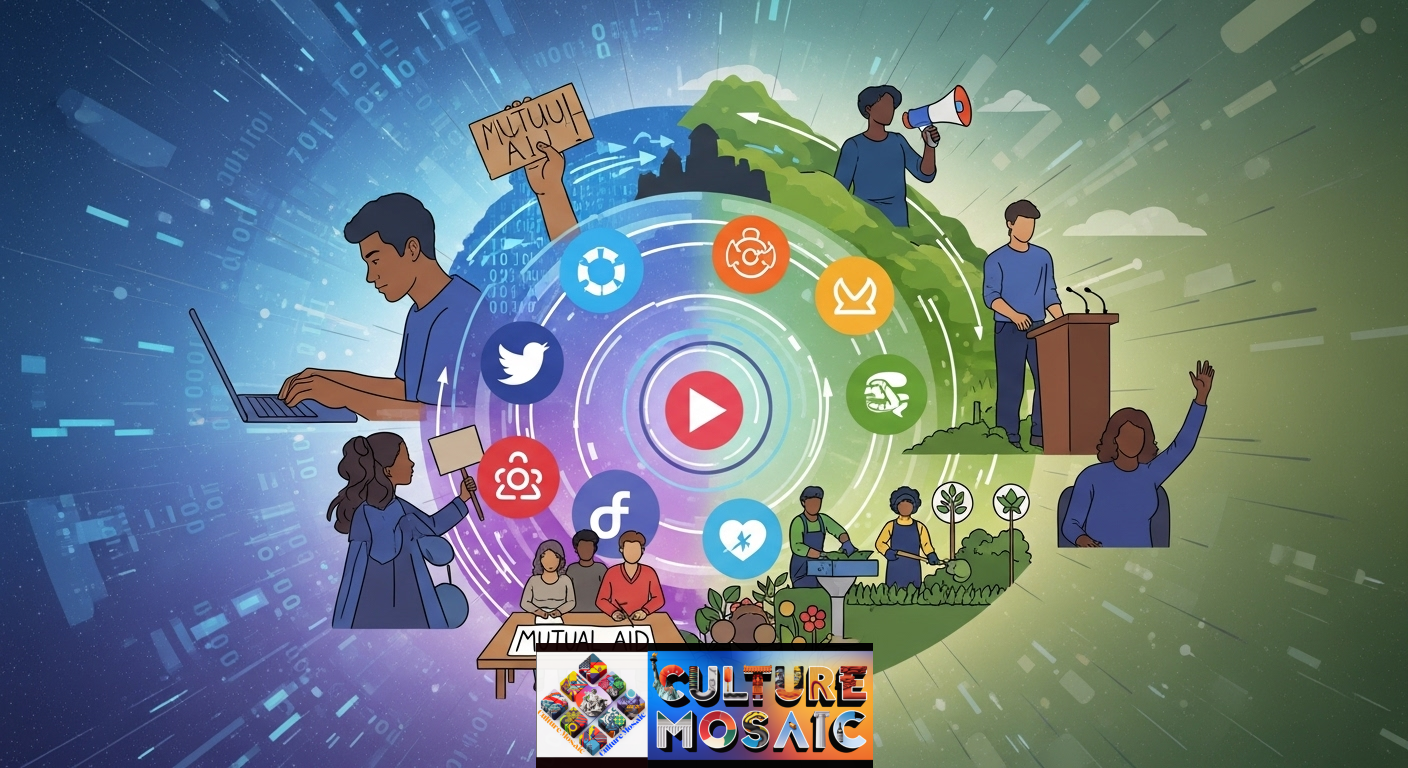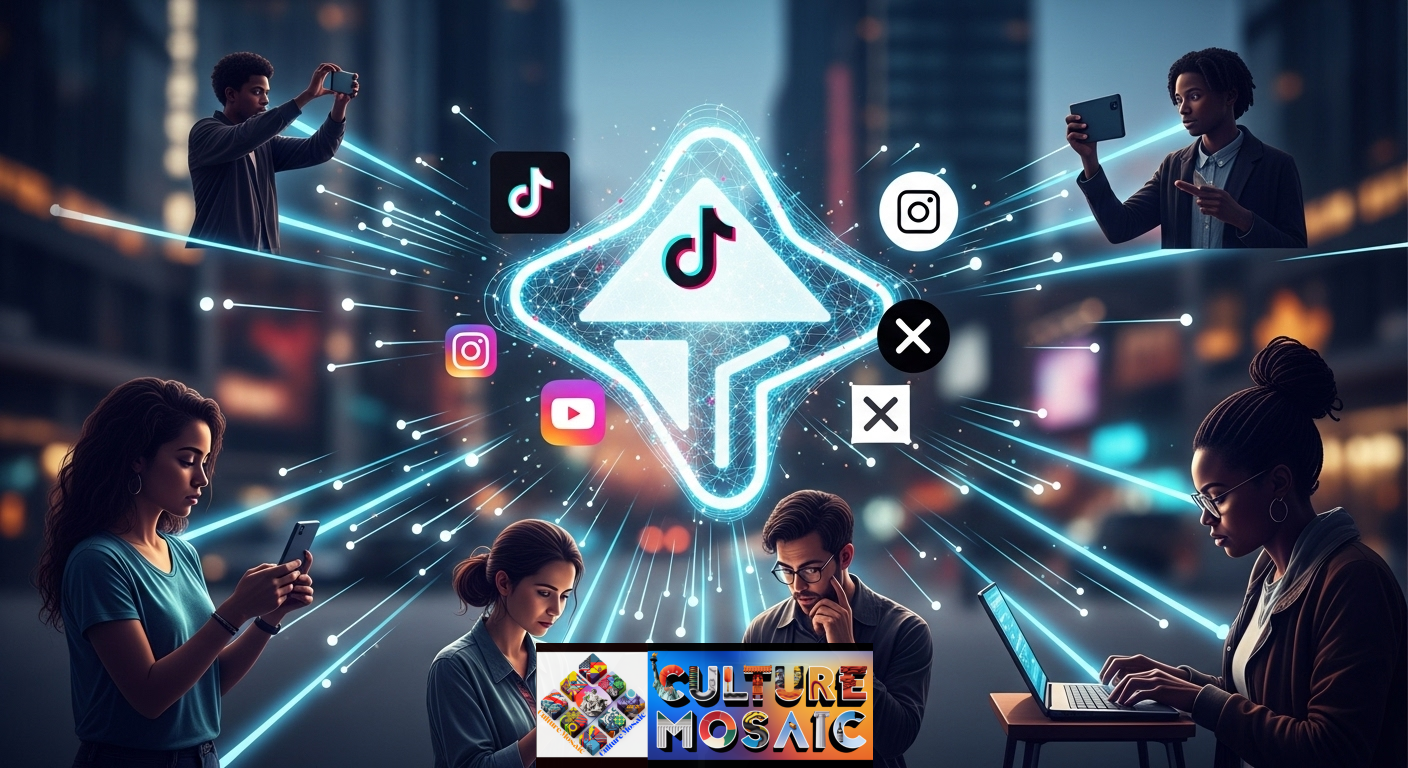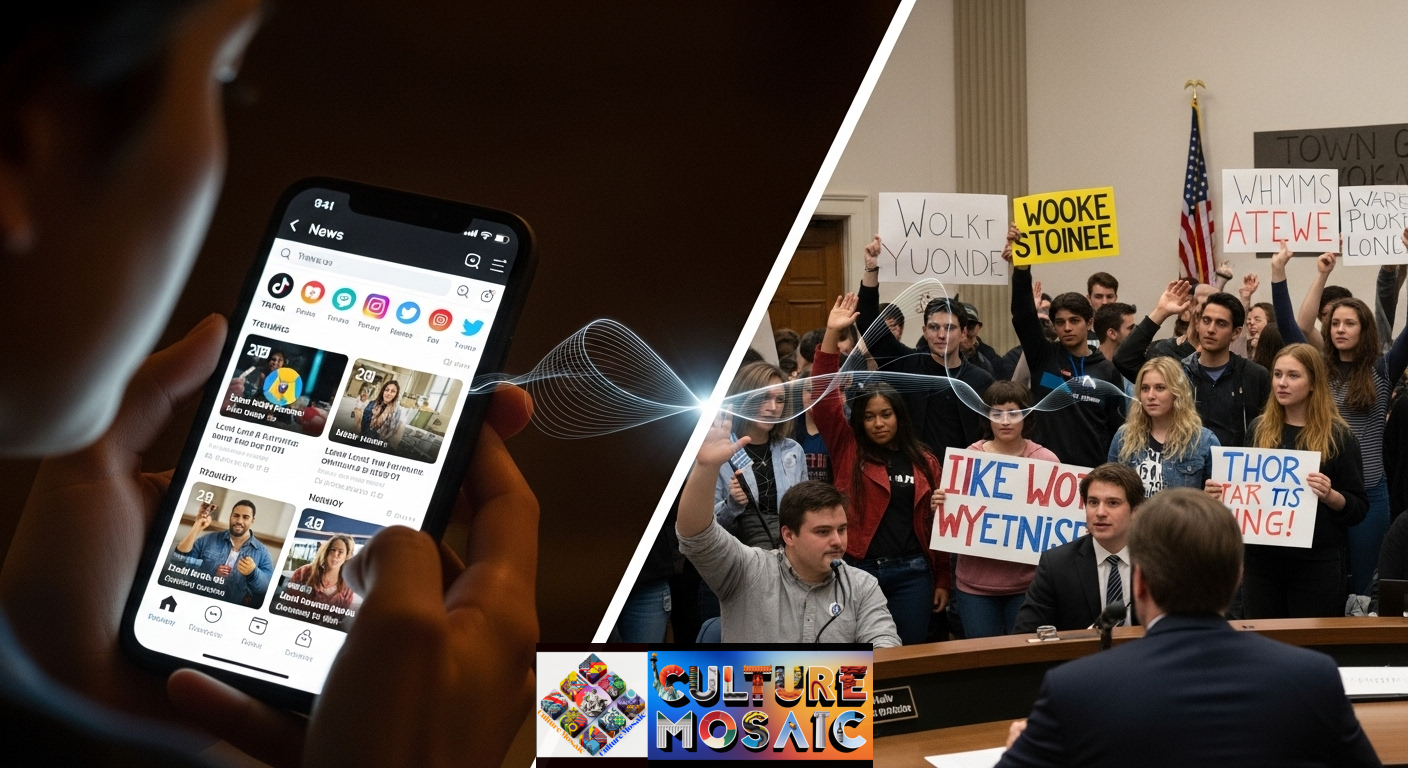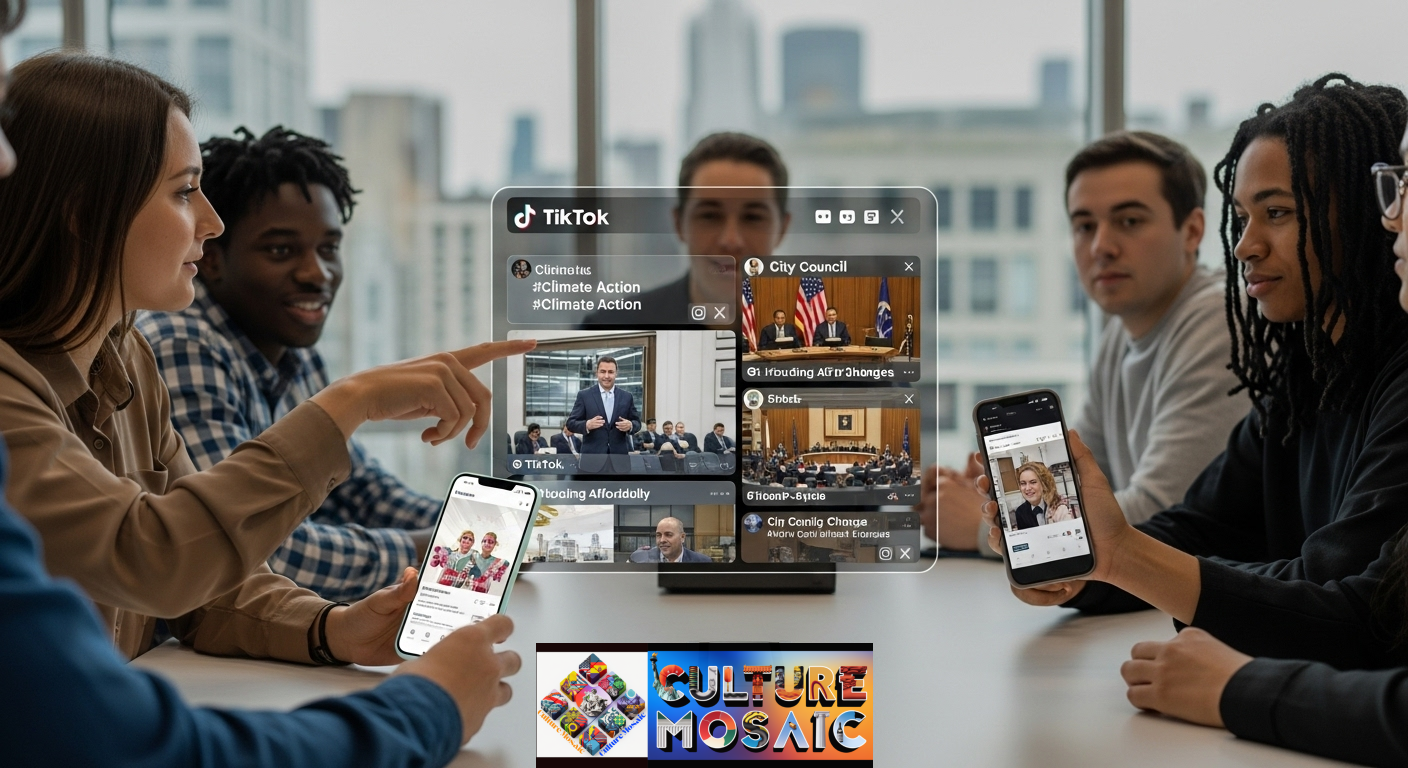The landscape of American democracy is experiencing a significant transformation, and Generation Z is at the forefront, using devices like smartphones to amplify their voices. Civic engagement among Gen Z has moved beyond traditional methods, such as writing letters to Congress or occasionally participating in protests. Today’s youth activists are reshaping the playbook by combining viral TikTok campaigns with strategic presence at city council meetings. They are demonstrating that the future of political participation does not conform to established norms defined by previous generations.
This change goes beyond simply changing methods; This involves reimagining citizen participation in the digital age. For example, climate strikes are now organized through Instagram Stories, and housing advocacy campaigns often begin with trending hashtags that can lead to policy change at the local level. Gen Z’s approach to civic engagement marks a fundamental evolution in how Americans interact with their democracy.
Understanding Gen Z Civic Engagement: A New Political Reality

Gen Z civic engagement differs dramatically from the activism of Millennials, Gen X, or Baby Boomers. Born between 1997 and 2012, this generation has never known a world without the internet, social media, or smartphones. Their approach to civic participation reflects this digital-native reality.
Traditional civic engagement typically followed a linear path: read the newspaper, form an opinion, perhaps join an organization, maybe attend a meeting. Gen Z civic engagement operates more like a network—information spreads rapidly across multiple platforms, organizing happens in real-time, and action can be both digital and physical, often simultaneously.
The statistics tell a compelling story. Research shows that young voters turned out in record numbers in recent elections, with many citing social media as their primary source of political information. But Gen Z civic engagement extends far beyond just voting. This generation volunteers at higher rates than previous cohorts, participates in boycotts, engages in mutual aid, and shows up to local government meetings in unprecedented numbers.
What makes Gen Z civic engagement particularly distinctive is its intersectionality and issue-based focus. Rather than aligning strictly along partisan lines, young activists organize around specific causes—climate justice, racial equity, LGBTQ+ rights, gun violence prevention, mental health access—and they’re willing to work across traditional political divides to achieve concrete results.
The Algorithm as Organizer: How Social Media Powers Gen Z Civic Engagement

The most visible manifestation of Gen Z civic engagement happens on platforms like TikTok, Instagram, Twitter (now X), and YouTube. For this generation, social media isn’t just a communication tool—it’s the primary infrastructure for political organizing, education, and mobilization.
TikTok, in particular, has emerged as an unexpected powerhouse of Gen Z civic engagement. The platform’s algorithm can catapult a local issue into national consciousness within hours. A 60-second video about a school board banning books can reach millions of viewers, sparking coordinated action across multiple states. The platform’s format—short, engaging, often humorous—makes complex political issues accessible without dumbing them down.
Instagram has become the hub for sustained Gen Z civic engagement campaigns. Organizers use Stories for real-time updates from protests or town halls, the main feed for educational content and calls to action, and Reels for viral awareness campaigns. The platform’s visual nature makes it particularly effective for humanizing political issues—putting faces and personal stories to abstract policy debates.
This digital dimension of Gen Z civic engagement offers several advantages over traditional organizing. First, it’s fast. When the Supreme Court overturned Roe v. Wade, protests were organized within hours through social media networks. Second, it’s scalable. A single person with a compelling message can reach millions without the backing of a major organization or media outlet. Third, it’s democratic. You don’t need wealth, institutional connections, or elite education to have your voice heard—just a smartphone and something important to say.
However, Gen Z civic engagement through social media also faces legitimate criticisms. The term “slacktivism”—activism that requires minimal effort and may produce minimal results—haunts digital organizing. Critics argue that sharing an infographic or adding a filter to your profile picture doesn’t constitute meaningful civic participation. There’s concern that the dopamine hit of likes and shares creates an illusion of impact without actual political change.
The most sophisticated Gen Z civic engagement strategies acknowledge these limitations and use social media as one tool among many, not the only tool.
The Local Politics Revolution: Where Gen Z Civic Engagement Gets Real Results

While social media captures headlines, the most significant evolution in Gen Z civic engagement might be happening in places most Americans ignore: city council meetings, school board sessions, zoning hearings, and community planning forums.
This focus on local politics represents a major shift in Gen Z civic engagement strategy. After years of national political exhaustion—endless federal gridlock, performative partisan battles, and a sense that individual voices don’t matter in Washington—young people are discovering that local government offers something increasingly rare in American politics: the ability to see direct results from civic participation.
Gen Z civic engagement at the local level makes intuitive sense when you consider the issues this generation cares about most. Housing affordability? Your city’s zoning laws and development policies have more immediate impact than any federal housing legislation. Climate change? Local ordinances on renewable energy, public transit investment, and building codes create tangible environmental improvements. Police reform? City budgets and local oversight boards determine actual police practices in your community.
The beauty of Gen Z civic engagement focused on local politics is the tight feedback loop between action and outcome. Show up to three city council meetings about bike lane infrastructure, organize your neighbors, present data, and you might actually see those bike lanes built within a year. That’s dramatically different from the national political experience where even popular policies can languish for decades.
Young people are also discovering that local government is often shockingly accessible. Many city council members don’t have large staffs or security details. You can email them directly, meet them at community events, or simply show up during public comment periods. This accessibility makes Gen Z civic engagement at the local level feel more authentic and less performative than engaging with distant federal officials.
The pivot to local politics in Gen Z civic engagement has produced tangible wins. In cities across America, young activists have successfully advocated for participatory budgeting programs that give residents direct say over public spending. They’ve pushed for tenant protections in increasingly unaffordable housing markets. They’ve reformed local policing practices and expanded access to mental health services. These aren’t symbolic victories—they’re real policy changes that improve people’s daily lives.
Bridging Digital and Physical: The Most Effective Gen Z Civic Engagement Strategies

The false dichotomy between online and offline activism misses the point of how Gen Z civic engagement actually works. The most effective young organizers don’t choose between TikTok and town halls—they use both strategically, understanding that different tools serve different purposes in the civic engagement ecosystem.
Successful Gen Z civic engagement campaigns typically follow a pattern: identify and raise awareness through social media, educate and build community online, then mobilize for concrete offline action, and finally, document and amplify the results back through digital channels.
Consider a hypothetical but representative example of Gen Z civic engagement in action: A group of young people in a mid-sized city learn that their city council is considering a development project that would demolish affordable housing to build luxury apartments.
- Phase 1 – Awareness (Digital): The story breaks on TikTok. A resident creates a video explaining the issue in 60 seconds, using local footage and clear graphics. The video goes viral within the community, reaching tens of thousands of residents who might otherwise never hear about a routine city council agenda item.
- Phase 2 – Education (Digital): Instagram becomes the hub for deeper engagement. Organizers share infographics explaining zoning laws, the development approval process, and when public comment periods occur. They share personal stories from residents who would be displaced. They provide context about the broader housing crisis.
- Phase 3 – Mobilization (Physical): Here’s where Gen Z civic engagement shows its muscle. Organizers use social media to coordinate attendance at city council meetings. They create sign-up sheets for people to deliver public comments. They organize a phone banking campaign to reach older residents who aren’t on social media but would be affected by the decision.
- Phase 4 – Documentation (Digital + Physical): Young activists live-stream the city council meeting on Instagram, providing real-time commentary. They film their public comments and share them online. When council members make statements, those clips circulate immediately on Twitter, creating accountability.
- Phase 5 – Sustained Pressure (Digital + Physical): The campaign doesn’t end after one meeting. Gen Z civic engagement excels at sustained attention. Organizers maintain pressure through a combination of continued social media presence, attendance at every relevant meeting, direct outreach to council members, and building coalitions with established community organizations.
This multi-channel approach addresses the “slacktivism” critique head-on. Gen Z civic engagement at its best uses digital tools for what they do well—rapid information sharing, mass coordination, lowering barriers to participation—while recognizing that achieving actual policy change still requires traditional forms of political pressure: bodies in seats at meetings, phone calls, relationship-building with decision-makers, and sustained attention over time.
The hybrid model of Gen Z civic engagement also builds more durable movements. The social media component helps recruit people who might never have considered attending a government meeting. Once they attend one meeting and see how accessible local government is, many become long-term participants. The digital tools lower the barrier to entry, but the physical participation creates the deeper commitment.
The Infrastructure of Gen Z Civic Engagement: New Tools for New Tactics

Beyond social media platforms, Gen Z civic engagement increasingly relies on a growing ecosystem of digital tools designed specifically for civic participation. These platforms bridge the gap between casual concern and meaningful action, providing infrastructure that makes it easier for young people to translate their values into political power.
Apps like Countable, Resistbot, and 5 Calls have become staples of Gen Z civic engagement, simplifying the process of contacting elected officials. Rather than hunting down phone numbers and office addresses, these tools put your representatives’ contact information at your fingertips and often provide talking points on current issues. For a generation that grew up with Uber and DoorDash—apps that make complex logistics invisible—these tools feel intuitive.
Mutual aid networks have exploded among Gen Z, often coordinated through platforms like Google Docs, Signal, and specialized apps. This represents a distinct form of Gen Z civic engagement: the idea that community care is itself a political act, and that meeting immediate needs (food, housing, emergency funds) is as important as traditional advocacy. These networks became especially visible during the COVID-19 pandemic, when young people organized grocery delivery for vulnerable neighbors, fundraised for those facing economic hardship, and created community support systems that government assistance failed to provide.
Participatory budgeting platforms represent another frontier of Gen Z civic engagement. Cities from New York to Seattle have implemented systems where residents can propose and vote on how to spend portions of the public budget. Young people have embraced these platforms, using them to advocate for investments in climate infrastructure, community programs, and public spaces. This direct democracy approach appeals to a generation skeptical of traditional representative politics.
Even platforms not designed for activism have become tools of Gen Z civic engagement. Discord servers function as organizing hubs. Google Forms collect stories for advocacy campaigns. Linktree compiles resources for specific causes. Venmo and Cash App facilitate grassroots fundraising. This improvisational use of existing technology demonstrates the adaptive, resourceful nature of Gen Z civic engagement.
Beyond Slacktivism: When Gen Z Civic Engagement Drives Real Change
Critics of online activism often dismiss Gen Z civic engagement as performative, but the evidence tells a different story. When paired with strategic offline action, digital organizing has produced substantive political wins.
Climate activism provides perhaps the clearest example. Gen Z civic engagement on climate change began primarily online, with young activists like Greta Thunberg (technically Gen Z’s older sibling, but embraced by the generation) using social media to spread awareness. But the movement quickly evolved. The youth climate strikes of 2019 were coordinated largely through social media but manifested as millions of young people physically walking out of schools and taking to the streets worldwide. More importantly, Gen Z civic engagement on climate has translated into concrete policy victories at local, state, and national levels—from cities committing to renewable energy targets to universities divesting from fossil fuels.
Gun violence prevention demonstrates similar dynamics. After the Parkland shooting, student survivors used social media to organize March for Our Lives, one of the largest youth-led protests in American history. But Gen Z civic engagement on this issue didn’t stop with marches. Young activists lobbied legislators, registered voters, and in multiple states, successfully pushed for “red flag” laws and other gun safety measures. They showed up, they stayed engaged, and they delivered results.
Housing advocacy has become a growing focus of Gen Z civic engagement, particularly in expensive coastal cities. Young activists have become fluent in the arcane language of zoning regulations, attended countless planning meetings, and successfully pushed for reforms that allow more housing construction. In Minneapolis, youth advocates were instrumental in the campaign that led the city to eliminate single-family zoning, a major shift in urban housing policy.
These examples share common features that define effective Gen Z civic engagement: they start with authentic passion for an issue, use digital tools strategically for organizing and awareness, translate online energy into physical participation, target specific policy changes rather than vague goals, and maintain sustained attention over time.
The success of Gen Z civic engagement also comes from its coalition-building approach. Young activists have learned to partner with established organizations that have policy expertise and institutional relationships, while bringing fresh energy, digital fluency, and moral urgency to campaigns. This intergenerational collaboration amplifies the impact of Gen Z civic engagement.
The Challenges Facing Gen Z Civic Engagement
For all its innovations and successes, Gen Z civic engagement faces significant obstacles. Understanding these challenges is crucial for anyone interested in supporting or participating in youth activism.
Digital divides remain a persistent issue. While social media dominates Gen Z civic engagement, not all young people have equal access to these platforms or the time to be constantly online. Rural youth, low-income youth, and those from marginalized communities may face barriers to participation in digitally-organized movements. Effective Gen Z civic engagement must grapple with these disparities.
Burnout is endemic among young activists. The 24/7 nature of social media, combined with the urgency of multiple overlapping crises—climate change, democratic backsliding, economic precarity, a pandemic—creates intense pressure. Gen Z civic engagement risks consuming the very people it depends on. Building sustainable activism that allows for rest and boundaries remains an ongoing challenge.
Misinformation poses particular risks for Gen Z civic engagement. The same algorithms that can spread awareness of important issues also spread false information, conspiracy theories, and manipulative content. Young activists must develop media literacy skills while also organizing politically—a double burden that previous generations didn’t face to the same degree.
Institutional resistance to Gen Z civic engagement takes various forms. Older generations sometimes dismiss young activists as naive or uninformed. Government officials may be unresponsive to youth concerns. Political systems designed for previous eras may not accommodate new forms of participation. Overcoming this resistance requires persistence and strategic thinking.
Co-optation is an ever-present danger. Corporations and politicians quickly learned to mimic the aesthetic of Gen Z civic engagement—speaking the language of social justice, posting infographics, expressing solidarity—without meaningful action. Distinguishing authentic engagement from performative allyship becomes increasingly difficult.
Despite these challenges, Gen Z civic engagement continues to evolve and adapt, finding new ways to make democracy responsive to young people’s concerns and values.
The Future of Gen Z Civic Engagement: Where Do We Go From Here?
The trajectory of Gen Z civic engagement suggests several likely developments in the coming years. Understanding these trends can help activists, educators, and institutions support effective youth participation in democracy.
First, expect Gen Z civic engagement to become increasingly sophisticated about local politics. As more young people discover the tangible results possible at the municipal level, we’ll likely see continued growth in youth participation in city councils, school boards, and local planning processes. This could fundamentally reshape urban policy across America.
Second, the integration of digital and physical organizing will deepen. Gen Z civic engagement will continue to blur the lines between online and offline activism, developing even more effective hybrid strategies. We may see new platforms specifically designed to facilitate this integration.
Third, issues of economic justice will likely become more central to Gen Z civic engagement. As this generation faces student debt, housing unaffordability, stagnant wages, and job precarity, expect to see more organizing around economic policy at all levels of government.
Fourth, Gen Z civic engagement may help rebuild trust in democratic institutions—if those institutions prove responsive. Young people haven’t given up on democracy, but they’re demanding that it actually work. Governments that embrace youth participation and transparent decision-making may find a newly engaged generation of citizens. Those that remain closed and unresponsive may face increasing legitimacy challenges.
Fifth, we’ll likely see continued innovation in the forms and tactics of Gen Z civic engagement. This generation’s creativity and adaptability suggest they’ll keep finding new ways to make their voices heard, whether through emerging technologies, new organizing models, or strategies we haven’t yet imagined.
How to Support and Participate in Gen Z Civic Engagement
Regardless of your age, there are concrete ways to support or participate in Gen Z civic engagement:
If you’re a young person:
Start local. Identify an issue that affects your community—housing, education, environment, public safety—and research who makes decisions about it. Attend one local government meeting, even if just to observe. You’ll often be surprised how accessible these spaces are and how much impact a few dedicated residents can have.
Build your civic literacy. Learn how your local government works, when decisions get made, and who represents you. Follow local journalists and officials on social media. Understanding the system makes you more effective at changing it.
Find your people. Join existing organizations working on issues you care about. If none exist, start a group chat with friends who share your concerns. Gen Z civic engagement is most sustainable when it’s collaborative and community-based.
Use your digital fluency strategically. Create content that explains complex issues simply, amplify voices that need to be heard, and use online tools to coordinate offline action. But remember that social media is the beginning of civic engagement, not the end.
Take care of yourself. Effective Gen Z civic engagement requires stamina. Build in rest, celebrate small wins, and create community with other activists so you can sustain your participation long-term.
If you’re an older person who wants to support Gen Z civic engagement:
Listen without dismissing. Young people bring fresh perspectives and genuine concerns. Even when their tactics differ from what you’re used to, their goals are often broadly shared across generations.
Share your knowledge. Gen Z activists benefit from learning about policy processes, institutional relationships, and lessons from past movements. Offer mentorship without trying to control or co-opt their work.
Use your resources and access. If you have institutional power, connections, or financial resources, consider how you can support Gen Z civic engagement. This might mean funding youth organizing, opening doors to decision-makers, or using your platform to amplify young voices.
Participate yourself. Gen Z civic engagement isn’t just for young people—it’s modeling new forms of democratic participation that can work for everyone. Try attending local government meetings, using digital tools for civic participation, or joining campaigns led by young organizers.
Conclusion: Gen Z Civic Engagement as Democratic Renewal
The story of Gen Z civic engagement is ultimately a story of democratic adaptation. Every generation must figure out how to make their voices heard within the political systems they inherit. Gen Z faces the particular challenge of doing so amid technological transformation, multiple overlapping crises, and widespread skepticism about traditional institutions.
What’s remarkable about Gen Z civic engagement isn’t just the tactics—the TikToks and Instagram campaigns and Discord organizing servers—but the underlying commitment to making democracy work. Young people haven’t retreated into cynicism or apathy, despite having plenty of reasons to do so. Instead, they’re innovating, experimenting, and finding new pathways to political power and civic influence.
From TikTok to town hall, Gen Z civic engagement represents both continuity and change. The core activities—organizing, educating, advocating, holding power accountable—remain fundamentally the same as they’ve always been. But the tools, tactics, and sensibilities bring something new to American democracy: digital fluency combined with local focus, intersectional awareness paired with pragmatic coalition-building, and the creative energy of young people who refuse to accept that the political system as it exists is the only system possible.
The success of Gen Z civic engagement will depend on many factors: whether institutions prove responsive to youth participation, whether young activists can sustain their energy over time, whether older generations offer support rather than dismissal, and whether the hybrid digital-physical organizing model can scale and deepen.
But if current trends continue, Gen Z civic engagement may be remembered as a pivotal moment in American democracy—the time when a new generation taught us that civic participation can look different than it used to, that local politics matters enormously, that digital tools can enhance rather than replace physical organizing, and that young people can drive substantive political change when given the opportunity.
The future of American democracy may well be written in TikTok comments and town hall testimony, in Instagram infographics and city council votes, in Discord servers and community organizing meetings. Gen Z civic engagement is showing us what that future could look like—if we’re willing to embrace new forms of participation while preserving the essential values of democratic engagement: participation, accountability, justice, and the fundamental belief that people working together can improve their communities and their country.
Frequently Asked Questions About Gen Z Civic Engagement
Q: Is social media activism really effective, or is Gen Z civic engagement just “slacktivism”?
A: Gen Z civic engagement through social media is most effective when paired with offline action. While sharing a post alone may have limited impact, social media serves crucial functions in successful movements: raising awareness, coordinating action, lowering barriers to participation, and documenting outcomes.
The most effective Gen Z civic engagement strategies use digital tools to organize and amplify, then translate that energy into concrete actions like attending meetings, contacting officials, and sustained advocacy. Research shows that online activism often serves as a gateway to deeper civic participation, especially for young people.
Q: Why is Gen Z civic engagement focusing more on local politics instead of national issues?
A: Gen Z civic engagement has pivoted toward local politics for several practical reasons. Local government decisions directly impact daily life through housing policy, policing, education, and environmental regulations. Results are more immediate—you can see concrete changes from local advocacy within months rather than years. Local officials are more accessible, making Gen Z civic engagement feel more impactful and authentic.
Additionally, after years of federal gridlock, young people are discovering that local politics offers more opportunities for meaningful change. This doesn’t mean Gen Z has abandoned national issues, but rather that they’ve recognized local government as a powerful lever for addressing the problems they care about.
Q: How can I get involved in Gen Z civic engagement if I’m not on social media or don’t have a large following?
A: Effective Gen Z civic engagement doesn’t require social media fame or a large platform. Start by attending local government meetings related to issues you care about—city councils, school boards, planning commissions. These meetings often have public comment periods where any resident can speak. Join existing organizations working on causes that matter to you; they need volunteers for phone banking, canvassing, research, and community outreach. Use tools like Resistbot or Countable to contact elected officials easily.
Participate in participatory budgeting if your city offers it. Gen Z civic engagement succeeds through collective action, not individual celebrity, so your consistent participation matters more than your follower count.
Q: What issues are driving Gen Z civic engagement most strongly?
A: Gen Z civic engagement centers on several key issues: climate change and environmental justice, with young activists pushing for renewable energy, conservation, and climate policy at all levels of government; racial justice and equity, addressing systemic racism through police reform, criminal justice changes, and anti-discrimination measures; LGBTQ+ rights, particularly protecting transgender youth and fighting discriminatory legislation; gun violence prevention, advocating for common-sense gun safety measures; economic justice, including housing affordability, student debt, and living wages; and mental health access, working to expand services and reduce stigma.
What distinguishes Gen Z civic engagement is its intersectional approach—recognizing how these issues connect and affect different communities in different ways.
Q: How can older generations support Gen Z civic engagement without taking over or co-opting youth movements?
A: Supporting Gen Z civic engagement while respecting youth leadership requires intentional approach. Listen to young activists’ priorities and concerns without dismissing them as naive or uninformed, even when their tactics differ from traditional approaches. Offer mentorship and share knowledge about policy processes and institutional relationships when asked, but don’t insist young people must do things “your way.” Use your resources, access, and institutional power to open doors and amplify youth voices rather than speaking over them.
Participate in campaigns and show up to events, following the leadership of young organizers. Advocate within your own networks and institutions for taking Gen Z civic engagement seriously. Most importantly, recognize that this generation brings valuable perspectives and innovations to democratic participation—supporting them means learning from them as much as teaching them.

